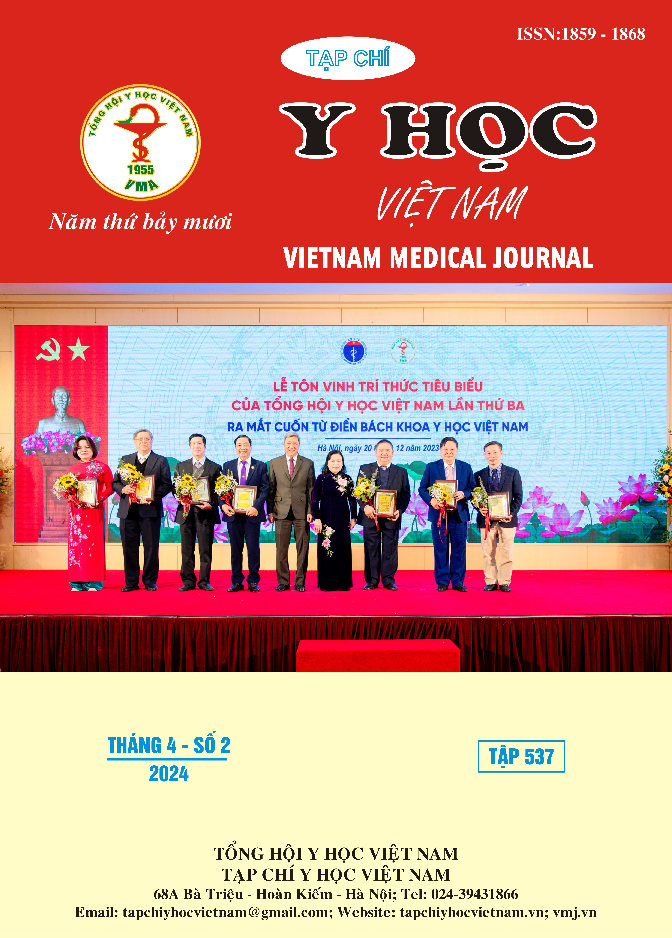STUDY THE RATE OF THE REMOVED GASTRIC SUBMUCOSAL TUMORS
Main Article Content
Abstract
Objectives: Determine the rate of the removed gastric submucosal tumors. Subjects and methods: Select the entire sample prospective and retrospective, cross-sectional descriptive study on 110 patients with gastric submucosal tumors at the Bach Mai Hospital from September 2021 to August 2023. Results: The average age is 52.7 ± 14.5 years old, and the male/female ratio is 1/1.5. Most patients have no clinical symptoms and are discovered incidentally through gastric endoscopy (43.6%). Tumor location is in the body of the stomach (50.8%). The average size is 4.15±2.5cm, mainly 2-5 cm (47.3%). On upper gastrointestinal endoscopy images, submucosal tumors are often raised lesions with smooth surfaces (70%). Regarding the histopathological type of tumor, GIST accounts for 67.3%. Ectopic pancreas, leiomyoma, and schwannoma account for 8.2%, 7.3%, and 6.4%, respectively. 4.5% of tumors are inflammatory fibrous polyps. Glomus tumors and lipomas account for 2.7%. There was 1 case of a gastric submucosal tumor that was metastatic HCC, accounting for 0.9% of the total samples in the study. A close positive linear correlation exists between the actual tumor size on the specimen after tumor resection and the estimated tumor size on conventional endoscopy. Conclusions: GIST were 67.3%, Ectopic pancreas were 8.2%, leiomyoma were 7.3%, Glomus tumors and lipomas account for 2.7%.
Article Details
Keywords
Gastric submucosal tumor, histopathological type.
References
2. Nishida T, Kawai N, Yamaguchi S, Nishida Y. Submucosal tumors: comprehensive guide for the diagnosis and therapy of gastrointestinal submucosal tumors. Digestive Endoscopy. 2013; 25(5):479-489.
3. Sharzehi K, Sethi A, Savides T. AGA clinical practice update on management of subepithelial lesions encountered during routine endoscopy: expert review. Clinical Gastroenterology and Hepatology. 2022;20:2435–2443.
4. Liu S, Zhou X, Yao Y, Shi K, Yu M, Ji F. Resection of the gastric submucosal tumor (G-SMT) originating from the muscularis propria layer: comparison of efficacy, patients’ tolerability, and clinical outcomes between endoscopic full-thickness resection and surgical resection. Surgical Endoscopy. 2020;34:4053-4064.
5. Trần Văn Huy, Nguyễn Thanh Long. Siêu âm nội soi trong chẩn đoán u dưới niêm mạc ống tiêu hóa tại Bệnh viện Trường Đại học Y dược Huế. Tạp chí Y Dược học - Trường Đại học Y Dược Huế. 2019;9(2):17-20.
6. Lim YJ, Son HJ, Lee J-S, et al. Clinical course of subepithelial lesions detected on upper gastrointestinal endoscopy. World Journal of Gastroenterology: WJG. 2010;16(4):439.
7. Lee HH, Hur H, Jung H, Jeon HM, Park CH, Song KY. Analysis of 151 consecutive gastric submucosal tumors according to tumor location. Journal of Surgical Oncology. 2011;104(1):72-75.
8. Ponsaing LG, Kiss K, Hansen MB. Classification of submucosal tumors in the gastrointestinal tract. World Journal of Gastroenterology: WJG. 2007; 13(24):3311.
9. Yoon JY, Shim CN, Chung SH, et al. Impact of tumor location on clinical outcomes of gastric endoscopic submucosal dissection. World Journal of Gastroenterology: WJG. 2014;20(26):8631.


